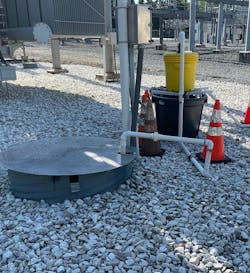No utility is immune to high-voltage transmission and distribution transformer hydrocarbon spills. Whether it is a failed gasket, a leaking valve or an unplanned release, every utility has experienced these. While the experience of such events is universal, the approaches to cleanup and remediation vary across different utilities.
Until recently, Baltimore Gas and Electric Co.’s (BGE’s) typical remediation of a high-voltage transformer spill within an oil retention pit (ORP) consisted of removing the stone from the pit, replacing the felt liner, power washing the pit and then reinstalling all the components. This mitigation solution can be costly, potentially exceeding half a million dollars. Oil-contaminated materials must be disposed of in accordance with local regulations to minimize the environmental impact.
With more than 200 substations, several thousand assets and an average of at least one release per year, BGE’s remediation efforts incur significant costs.
Embracing The Challenge
BGE is committed to environmental protection and has a thorough training program for handling spills. In the summer of 2022, the utility experienced a hydrocarbon release of approximately 285 gal (1079 liter) due to a partially opened valve on a pressure-relief device associated with the conservator tank of a 110/13-kV power transformer. The spill was appropriately contained in the mother pit.
Following the recent replacement of the pit, the cost associated with cleaning it and BGE’s commitment to protecting the environment, the utility’s leadership tasked employees with developing a cost-effective solution. The construction and maintenance team embraced the challenge and began researching industry-standard spill hydrocarbon mitigation techniques. They formed a multidisciplinary team of engineers, environmental scientists, field technicians and consultants to tackle the issue.
The Bright Idea
The team conceived the idea of adapting and prototyping a decanter system manufactured by HalenHardy, which provides products and services for spill containment and cleanup. The oil decanter features filters that allow oil-contaminated water to be processed, enabling the water to be either discarded if it meets regulatory discharge limits or returned to the pit or another containment area.
Following several iterations with the manufacturer, BGE installed the decanter system on its mother pit. A modification was made to include a sump pump with an oil-smart switch — to prevent any oil from being reintroduced into the pit. The oil-smart pump switch controls the water level by activating the pump to operate when it senses water at the on and off points. When the probes sense oil, the pump is turned off, thereby preventing the discharge of oil from the sump pit. When combined with a sump pump, the oil-smart pump switch allows water to be pumped without the risk of pumping oil.
BGE also routed the discharge pipe to the highest point of the pit system, to ensure clean water circulates through the pit system into the mother pit, thereby capturing any residual oil that might still be trapped in the filter cloth or stones. Additionally,the team devised a solution to introduce a surfactant that mobilizes the oil and cleanses the stone and filter liner. The utility applied an Environmental Protection Agency-approved dispersant at several locations over its ORP footprint, including the highest point. Additionally, it used a hot-water power washer to enhance infiltration and dispersion of the surfactant throughout the ORP.
BGE’s objective was to initiate and enhance the mobilization and migration of trapped oil — essentially flushing away residual oil coating the stone along with any oil trapped in the filter cloth — to the utility’s collection point.
After flushing the pit with surfactant, the utility deployed the decanter system and monitored its progress for several weeks, particularly following rain events. BGE’s team inspected the sump pit to verify the functionality of the decanter system and ensure the oil-smart switch had not been triggered. Regular inspections were conducted at multiple locations and at the decanter system’s discharge point until the visual presence of oil began to clear.
Transform Pollution Into Purity
In collaboration with BGE’s environmental team, it was determined that discharging the water back into the environment was not permissible until the appropriate regulatory discharge limits were met. Given the volume of oil and the extent of the contamination, the utility anticipated that removing the oil and achieving these limits would require several weeks of continuous system operation.
BGE deployed the decanter system in the fall of 2023 during the rainy season. This expedited the process and reduced cost by leveraging natural rainfall to provide the water to flush the pit. By February 2024, after successfully meeting the regulatory discharge limits, the utility’s environmental team approved commencement of discharging the water back into the environment. As of June 2024, the utility has continued to use the decanter system for discharging and plans to remove the prototype system entirely by the fall of 2024.
Although the process took nearly a year, it was significantly more cost effective than the alternative method of removing and replacing the stones and felt liner, power washing the pit and reinstalling the components, which would have taken only a few months. The prototype decanter system resulted in a 90% reduction in costs compared to the previous solution.
From Prototype To Production
Building on the prototype decanter system, the BGE team partnered with Ecotech to develop a final product that Ecotech will own, maintain and deploy in the event of a hydrocarbon release. By partnering with this company, BGE can leverage an environmental response vendor as a one-stop shop for managing both initial and post-cleanup activities comprehensively.
Ecotech designed a self-contained filtration system capable of removing sediment, residual oil and dissolved hydrocarbons. Similar to how the decanter system works, this self-contained unit can be deployed within 24 hours of a release and subsequent initial cleanup. The unit is mounted on a skid, making it easy to transport with a forklift and deploy at any required location.
BGE anticipates substantial cost savings by using this unit instead of its prior process. This final product represents a significant achievement not just for BGE but, most importantly, for the environment.








